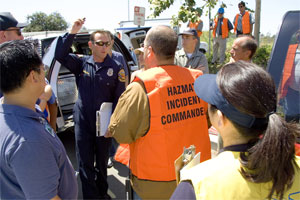Social Scientists Play Crucial Role in Project ResCUE
Oct. 17, 2006 -- Understanding human behavior is an essential aspect of ResCUE’s effort to improve emergency response. “You have to understand the social structure, both at the organizational level and at the individual level in order to design effective IT solutions,” says project director Sharad Mehrotra.
|
Carter Butts, UCI assistant professor of sociology, and his team of students work closely with social science researchers at the University of Colorado , Boulder to understand how humans act and react when facing crises.
“Technical infrastructure allows responders to operate more effectively, but at the end of the day, the work is done by ordinary people,” he says. “Understanding how humans organize in adverse circumstances is essential to improving the response process.”
Data Collection Yields Insight
The team employs a range of data-collection methods, including field observation, interviews with professional responders and focus groups.
They also employ archival sources, such as transcripts of radio communications, police reports and situation reports issued by organizations that responded to prior events.
Butts and his student researchers studied the Port Authority transcripts from 9-11-2001. The team gleaned some surprising information from those conversations, Butts says. “We found that the kinds of communication patterns exhibited by professional responders, like police, were strikingly similar to those of non-specialist responders, like elevator operators or maintenance personnel.”
The lesson learned was that most of the communications that day were performed by a small number of individuals who became ad hoc ‘hubs’ in the communication network. This finding underscores the role improvisation plays in emergency response, and points toward the need to develop flexible technology that considers this behavior.
Understanding, Predicting, Anticipating
While no one disputes that serious communications failures contributed to the tragic outcome on 9-11, Butts’ team made some startling discoveries from the transcripts. When team members analyzed the transcripts using recently developed statistical methods, they determined that many of the responder networks were generally well-connected. “We found within the Port Authority Police Department that communication failures did not lead to a total fragmentation of the responder interaction network,” Butts says. “Despite serious problems, responders at the World Trade Center were able to piece together a response which was well-connected in many respects.
“This testifies to the ability of human beings to work together during crisis situations and to improvise under extremely difficult conditions,” he continues. “This understanding allows us to make more accurate predictions regarding individual and organizational responses to disaster and may help us anticipate where communications will or will not break down in future events.”
Improving Response through Technology
In the 911 transcripts, many responders, including police, fire and Port Authority personnel, were calling operators with the same questions, such as, “Is the tunnel open?” Every time emergency operators had to answer that question, it prevented them from undertaking more important tasks.
“Some of the ResCUE technologies, such as call-processing automation, call prioritization and push-oriented dissemination, might help alleviate the load of call operators and improve response effectiveness,” says Nalini Venkatasubramanian, ResCUE researcher.
“The objective of technology is to obtain actionable information that results in the greatest impact,” Mehrotra summarizes. “This can only come from an understanding of the social process.”

